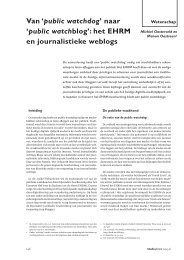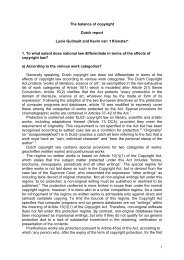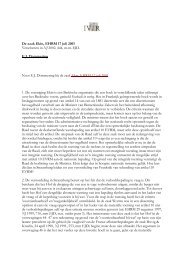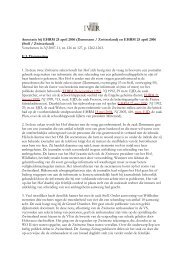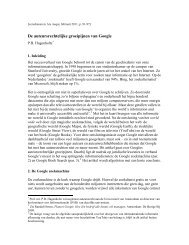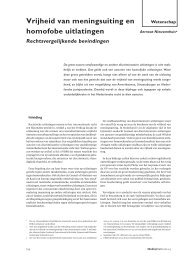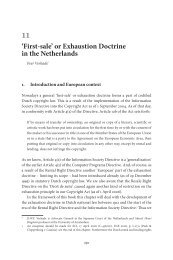European Copyright Code - IViR
European Copyright Code - IViR
European Copyright Code - IViR
Create successful ePaper yourself
Turn your PDF publications into a flip-book with our unique Google optimized e-Paper software.
De geschiedenis leert dat liberalisatieprojecten niet altijd<br />
de gewenste effecten sorteren. Er kan dus niet voetstoots<br />
vanuit worden gegaan dat de markt zelf alle problemen<br />
oplost. Daarom is de vraag legitiem of het nieuwe collectief<br />
beheer naast competitief ook doelmatig zal zijn.<br />
Deze vraag is door velen ontkennend beantwoord, omdat<br />
het te hoge culturele kosten met zich mee zou brengen:<br />
lokaal repertoire zou in de verdrukking komen, omdat het<br />
beheer ervan te duur zou worden. Hoewel op dit argument<br />
het een en ander valt af te dingen, blijven er wel andere<br />
bezwaren overeind. Zo zou het één-loket-systeem (met het<br />
gebruiksgemak van dien) eenvoudig kunnen verdwijnen<br />
als muziekauteurs het beheer bij verschillende organisaties<br />
onderbrengen. Ook is een marktimplosie niet ondenkbaar,<br />
waardoor een vrije markt zou kunnen ontaarden in een<br />
oligopolistische of monopolistische markt. Verder lijkt de<br />
Commissie nog geen visie te hebben ontwikkeld op de lange<br />
termijn. Als technologische ontwikkelingen ertoe leiden<br />
dat de inkomsten uit offline-beheer verder afnemen, zullen<br />
kleinere rechtenorganisaties wellicht omvallen. Het is niet<br />
duidelijk welke toekomst voor lokaal toezicht de Commissie<br />
in dat geval voor ogen staat.<br />
De opgedeelde markt voor collectief beheer is zonder twijfel<br />
aan hervorming toe. De strakke, nationale grenzen voor<br />
leden en licenties zijn steeds moeilijker te verdedigen. Het<br />
voornemen om deze grenzen op te heffen, is een begrijpelijk<br />
antwoord, maar daarmee nog niet adequaat. Zolang het<br />
collectief beheer nog niet wordt beheerst door uniforme,<br />
Europese wetgeving, bijvoorbeeld met betrekking tot tarifering,<br />
regels van goed bestuur en mechanismen voor geschilbeslechting,<br />
45 is liberalisering mogelijkerwijs prematuur.<br />
Door het gebrek aan dit juridische kader mist het debat<br />
soms richting: een nieuw model voor het collectief beheer,<br />
behoeft vaak ruime, additionele wetgeving. Mogelijke voorzetten,<br />
zoals gecentraliseerde licentieverstrekking, hebben<br />
daardoor een embryonaal karakter. Het welslagen van een<br />
effectief rechtenbeheer op communautair niveau, zal dus<br />
waarschijnlijk nog veel inspanningen van de Europese<br />
wetgever vergen. De oplossing die nu, bijna veertig jaar na<br />
de GEMA-zaak, 46 door de Commissie is gepresenteerd, valt<br />
voornamelijk op in eenvoud. Er mag voor worden gevreesd<br />
dat hierin tevens de zwakte schuilt.<br />
45 Zoals ook geuit door de Europese Commissie in een Mededeling aan de Raad,<br />
het Europees Parlement en het Europees Economisch en Sociaal Comité over<br />
het beheer van auteursrechten en naburige rechten in de interne markt,<br />
COM/2004/0261.<br />
46 In deze zaak was voor het eerst competitievervalsing in het collectief beheer<br />
aan de orde. Zie de Beschikking van de Europese Commissie van 20 juni 1971<br />
(GEMA I) PbEG L134/15.<br />
<strong>European</strong> <strong>Copyright</strong> <strong>Code</strong><br />
Introduction<br />
The <strong>European</strong> <strong>Copyright</strong> <strong>Code</strong> is the result of the Wittem<br />
Project that was established in 2002 as a collaboration<br />
between copyright scholars across the <strong>European</strong> Union concerned<br />
with the future development of <strong>European</strong> copyright<br />
law. The project has its roots in an International Network<br />
Program run by three Dutch universities (Radboud University<br />
of Nijmegen, University of Amsterdam and Leiden University),<br />
and sponsored by the government-funded Dutch<br />
ITeR Program.<br />
The aim of the Wittem Project and this <strong>Code</strong> is to promote<br />
transparency and consistency in <strong>European</strong> copyright<br />
law. The members of the Wittem Group share a concern<br />
that the process of copyright law making at the <strong>European</strong><br />
level lacks transparency and that the voice of academia all<br />
too often remains unheard. The Group believes that a <strong>European</strong><br />
<strong>Copyright</strong> <strong>Code</strong> drafted by legal scholars might serve<br />
as a model or reference tool for future harmonization or<br />
unification of copyright at the <strong>European</strong> level. Nevertheless,<br />
the Group does not take a position on the desirability<br />
as such of introducing a unified <strong>European</strong> legal framework.<br />
The <strong>Code</strong> was drafted by a Drafting Committee composed<br />
of seven members. 1 Each chapter of the <strong>Code</strong> was originally<br />
drafted by one or two members of the Drafting Commit-<br />
1 Members of the Drafting Committee:<br />
– Prof. Lionel Bently, Centre of Intellectual Property and Information Law,<br />
University of Cambridge; Emmanuel College, Cambridge;<br />
– Prof. Thomas Dreier, Institut für Informations- und Wirtschaftsrecht, Zentrum<br />
für angewandte Rechtswissenschaft, Karlsruhe Institute of Technology<br />
(KIT);<br />
– Prof. Reto Hilty, Max Planck Institute for Intellectual Property, Competition<br />
and Tax Law, Munich;<br />
– Prof. P. Bernt Hugenholtz, Instituut voor Informatierecht, Universiteit van<br />
Amsterdam;<br />
– Prof. Antoon Quaedvlieg, Radboud Universiteit Nijmegen;<br />
– Prof. Alain Strowel, Facultés universitaires Saint-Louis, Bruxelles ;<br />
– Prof. Dirk Visser, Universiteit Leiden.<br />
1 2 0 ami T I J D S C H R I F T V O O R A U T E U R S - , M E D I A - & I N F O R M A T I E R E C H T 2 0 1 0 - 4
tee, acting as rapporteurs. The rapporteurs for each chapter<br />
were: Prof. Quaedvlieg (Chapter 1: Works), Prof. Hugenholtz<br />
(Chapter 2: Authorship and ownership), Prof. Strowel<br />
(Chapter 3: Moral rights), Prof. Visser (Chapter 4: Economic<br />
rights) and Professors Dreier and Hilty (Chapter 5: Limitations).<br />
Each draft Chapter, accompanied by an explanatory<br />
memorandum, was discussed in a plenary session with the<br />
members of the Wittem Advisory Board 2 and other experts<br />
that were invited ad hoc. The proceedings of these plenary<br />
sessions were fed into the second versions of each chapter,<br />
and thereafter redacted and integrated into a final consolidated<br />
version by the Drafting Committee. Although discussions<br />
with the Advisory Board and experts have greatly<br />
influenced the final product, responsibility for the <strong>Code</strong><br />
lies solely with the Drafting Committee.<br />
While drafted in the form of a legislative instrument and<br />
thereby exceeding the level of detail normally associated<br />
with common principles of law, this <strong>Code</strong> is not comprehensive.<br />
It concentrates on the main elements of any codification<br />
of copyright: subject matter of copyright (Chapter 1),<br />
authorship and ownership (Chapter 2), moral rights (Chapter<br />
3), economic rights (Chapter 4) and limitations (Chapter<br />
5). The <strong>Code</strong> does not, for instance, treat such remuneration<br />
rights as public lending right and droit de suite, nor<br />
does it deal with the legal protection of technical measures.<br />
Also, the <strong>Code</strong> does not contain rules on copyright liability<br />
or enforcement, nor does it touch upon neighbouring<br />
(related) rights and database right.<br />
This <strong>Code</strong> is not a recodification of EU copyright law<br />
tabula rasa. Since <strong>European</strong> copyright law must operate<br />
within the confines of the international commitments of<br />
the <strong>European</strong> Union and its Member States, the <strong>Code</strong> takes<br />
account of the substantive norms of the Berne Convention<br />
and the TRIPs Agreement. Also, the members of the Group<br />
have found it hard to ignore the aqcuis communautaire in the<br />
form of seven Directives that the <strong>European</strong> legislature has<br />
produced in this field since 1991. However, the <strong>Code</strong> does<br />
on occasion deviate from the acquis, and therefore cannot<br />
be considered a mere restatement or consolidation of the<br />
norms of the directives.<br />
The members of the Wittem Group hope that this <strong>European</strong><br />
<strong>Copyright</strong> <strong>Code</strong> will contribute to the establishment<br />
of a body of transparent and consistent copyright law that<br />
protects the moral and economic interests of creators,<br />
while serving the public interest by promoting the production<br />
and dissemination of works in the field of literature,<br />
art and science.<br />
The <strong>European</strong> <strong>Copyright</strong> <strong>Code</strong> is available at www.copyrightcode.eu.<br />
Preamble<br />
The Wittem Group<br />
Considering<br />
– that the establishment of a fully functioning market<br />
for copyright protected works in the <strong>European</strong><br />
Union, as necessitated in particular by the Internet<br />
as the primary means of providing information and<br />
entertainment services across the Member States,<br />
requires common rules on copyright in the EU that<br />
reflect and integrate both the civil and common law<br />
traditions of copyright and authors’ right respectively;<br />
– that twenty years of harmonization has brought<br />
only partial harmonization on certain aspects of the<br />
law of copyright in the Member States of the EU;<br />
– that the consistency and transparency of the harmonized<br />
rules on copyright in the EU ought to be<br />
improved;<br />
– that copyright law in the EU should reflect the core<br />
principles and values of <strong>European</strong> law, including<br />
freedom of expression and information as well as<br />
freedom of competition;<br />
Recognizing<br />
– that copyright protection in the <strong>European</strong> Union<br />
finds its justification and its limits in the need to<br />
protect the moral and economic interests of creators,<br />
while serving the public interest by promoting<br />
the production and dissemination of works in the<br />
field of literature, art and science by granting to<br />
creators limited exclusive rights for limited times in<br />
their works;<br />
– that copyright legislation should achieve an optimal<br />
balance between protecting the interests of authors<br />
and right holders in their works and securing the<br />
freedom to access, build upon and use these works;<br />
– that rapid technological development makes future<br />
modes of exploitation and use of copyright works<br />
unpredictable and therefore requires a system of<br />
rights and limitations with some flexibility;<br />
2 Members of the Wittem Advisory Board:<br />
– Prof. Jon Bing, Institutt for rettsinformatikk, Universitetet i Oslo;<br />
– Prof. Robert Clark, University College Dublin;<br />
– Prof. Frank Gotzen, Centrum voor Intellectuele rechten, Katholieke Universiteit<br />
Leuven;<br />
– Prof. Ejan Mackaay, Université de Montréal;<br />
– Prof. Marco Ricolfi, Università degli Studi di Torino;<br />
– Prof. Elzbieta Traple, Uniwersytet Jagiellonski w Krakowie;<br />
– Prof. Michel Vivant, Université Montpellier 1;<br />
– Prof. Raquel Xalabarder, Universitat Oberta de Catalunya.<br />
2 0 1 0 - 4 ami T I J D S C H R I F T V O O R A U T E U R S - , M E D I A - & I N F O R M A T I E R E C H T<br />
1 2 1
Believing<br />
– that the design of a <strong>European</strong> <strong>Copyright</strong> <strong>Code</strong> might<br />
serve as an important reference tool for future legislatures<br />
at the <strong>European</strong> and national levels;<br />
Taking note<br />
– of the norms of the main international treaties in<br />
the field of copyright that have been signed and<br />
ratified by the EU and its Member States, in particular<br />
the Berne Convention, the TRIPs Agreement and<br />
the WIPO <strong>Copyright</strong> Treaty, and of the harmonized<br />
standards set by the EC directives in the field of copyright<br />
and related rights;<br />
Proposes the following <strong>European</strong> <strong>Copyright</strong> <strong>Code</strong>:<br />
Chapter 1: Works<br />
Art. 1.1 – Works<br />
(1) <strong>Copyright</strong> subsists in a work, 3 that is to say, any 4<br />
expression 5 within the field of literature, art or science 6 in<br />
so far as it 7 constitutes its author’s own 8 intellectual creation.<br />
9<br />
(2) The following in particular are regarded 10 to be within<br />
the field of literature, art or science within the meaning<br />
of this article:<br />
a. Written or spoken words,<br />
b. Musical compositions<br />
c. Plays and choreographies,<br />
d. Paintings, graphics, photographs and sculptures,<br />
e. Films,<br />
f. Industrial and architectural designs,<br />
g. Computer programs,<br />
h. Collections, compilations and databases.<br />
(3) The following are not, in themselves, 11 to be regarded<br />
as expressions within the field of literature, art or science<br />
within the meaning of this article: 12<br />
a. Facts, discoveries, news and data 13 ;<br />
b. Ideas and theories;<br />
c. Procedures, methods of operation and mathematical<br />
concepts. 14<br />
Art. 1.2 – Excluded works<br />
The following works are not protected by copyright:<br />
a. Official texts of a legislative, administrative and<br />
judicial nature, including international treaties, as<br />
well as official translations of such texts;<br />
b. Official documents published 15 by the public<br />
authorities. 16<br />
Chapter 2: Authorship and ownership<br />
Art. 2.1 – Authorship<br />
The author of a work is the natural person or group of<br />
natural persons who created it. 17<br />
Art. 2.2 – Moral rights<br />
(1) The author of the work has the moral rights.<br />
(2) Moral rights cannot be assigned.<br />
Art. 2.3 – Economic rights<br />
(1) The initial owner of the economic rights in a work is<br />
its author.<br />
(2) Subject to the restrictions of article 2.4, the economic<br />
rights in a work may be assigned, 18 licensed 19 and<br />
passed by inheritance, in whole or in part.<br />
3 The term ‘work’ is used throughout this <strong>Code</strong> as a general term to denote<br />
subject matter protected by copyright as defined in this article. It does not<br />
cover subject matter protected by what is usually referred to as neighbouring<br />
or related rights.<br />
4 ‘Any’ denotes ‘whatever may be its mode or form of expression or its merit’.<br />
There is no requirement of fixation. An adaptation of a work may qualify as a<br />
work itself.<br />
5 The term ‘expression’ indicates the traditional requirement that works be the<br />
result of the author’s personal expression.<br />
6 The term ‘literary, artistic or scientific expressions’, which is inspired by art.<br />
2(1) BC, circumscribes the domain of copyright, and serves as ‘Oberbegriff’.<br />
7 ‘In so far as’ indicates that the requirement of constituting ’its author’s own,<br />
intellectual creation’ is not merely a condition for the existence of copyright,<br />
but also defines its limits.<br />
8 The <strong>Code</strong> does not use or define the term original, but in practice it might still<br />
be used to indicate that the production qualifies as a (protected) work.<br />
9 The term ‘the author’s own intellectual creation’ is derived from the acquis<br />
(notably for computer programs, databases and photographs). It can be interpreted<br />
as the ‘average’ <strong>European</strong> threshold, presuming it is set somewhat<br />
higher than skill and labour. This is possible if emphasis is put on the element<br />
of creation. For factual and functional works, the focus will be more on a<br />
certain level of skill (judgement) and labour, whereas for productions in the<br />
artistic field the focus will be more on personal expression.<br />
10 The categories listed here are merely examples and should not be taken to be<br />
exhaustive. The exemplary list indicates ‘core’ areas of copyright.<br />
11 The term ‘as such’ has built up a lot of jurisprudence under the EPC art. 52,<br />
and is therefore avoided here.<br />
12 Whereas art. 1.1(3) designates subject matter that as a matter of principle does<br />
not fall within the domain of copyright, art. 1.2 deals with works that do fall<br />
within the domain of copyright, but are excluded from copyright protection.<br />
13 Cf. art. 10(2) TRIPs: such protection shall not extend to the data or material<br />
itself; see also art. 3(2) Database Directive.<br />
14 Cf. art. 9(2) TRIPs.<br />
15 The term ‘published’ does not imply that a work must formally have been<br />
published in an Official Journal or equivalent. However, secret or confidential<br />
information can not be considered as ‘published’.<br />
16 As to ‘official’ works by private authors, these will be protected until they<br />
become ‘official’. Also, questions of moral rights could still arise despite the<br />
exclusion.<br />
17 In case of films such co-authors include the director, the author of the screenplay<br />
and the author of the dialogue and the composer of music specifically<br />
created for use in the cinematographic or audiovisual work; see art. 2(2) Term<br />
Directive.<br />
18 The term ‘assignment’ indicates a cession of economic rights; ownership of<br />
the rights is transferred to another person.<br />
19 The term ‘license’ indicates an act of authorisation (permission) to use the<br />
work.<br />
1 2 2 ami T I J D S C H R I F T V O O R A U T E U R S - , M E D I A - & I N F O R M A T I E R E C H T 2 0 1 0 - 4
(3) If the author has assigned economic rights, he shall<br />
nonetheless have a right to an adequate part of the<br />
remuneration on the basis of the provisions in articles<br />
5.2, 5.3, 5.4 and 5.5.<br />
(4) An assignment is not valid unless it is made in writing.<br />
Art. 2.4 – Limits<br />
If the contract by which the author assigns or exclusively<br />
licenses the economic rights in his work does not adequately<br />
specify (a) the amount of the author’s remuneration, (b)<br />
the geographical scope, (c) the mode of exploitation and (d)<br />
the duration of the grant, 20 the extent of the grant shall be<br />
determined in accordance with the purpose envisaged in<br />
making the grant. 21<br />
Art. 2.5 – Works made in the course of employment<br />
Unless otherwise agreed, the economic rights in a work<br />
created by the author in the execution of his duties or following<br />
instructions given by his employer 22 are deemed to<br />
be assigned to the employer.<br />
Art. 2.6 – Works made on commission<br />
Unless otherwise agreed, the use of a work by the commissioner<br />
of that work is authorized to the extent necessary<br />
to achieve the purposes for which the commission was<br />
evidently made. 23<br />
Chapter 3: Moral rights<br />
Art. 3.1 – General<br />
The moral rights in a work are the rights of divulgation,<br />
attribution and integrity, as provided for in articles 3.2, 3.3<br />
and 3.4.<br />
Art. 3.2 – Right of divulgation<br />
(1) The right of divulgation is the right to decide whether,<br />
and how the work is disclosed for the first time.<br />
(2) This right shall last for the life of the author. 24<br />
Art. 3.3 – Right of attribution<br />
(1) The right of attribution comprises:<br />
a. the right to be identified as the author, 25 including<br />
the right to choose the manner of identification,<br />
26 and the right, if the author so decides, to<br />
remain unidentified.<br />
b. the right to require that the name or title which<br />
the author has given to the work be indicated.<br />
(2) This right shall last for the life of the author and<br />
until [...] years after his death. 27 The legal successor<br />
as defined by the laws on inheritance 28 is entitled to<br />
exercise the rights after the death of the author.<br />
Art. 3.4 – Right of integrity<br />
(1) The right of integrity is the right to object to any distortion,<br />
mutilation or other modification, or other<br />
derogatory action in relation to the work, which<br />
would be prejudicial to the honour or reputation of<br />
the author.<br />
(2) This right shall last for the life of the author and<br />
until [...] years after his death. The legal successor<br />
as defined by the laws on inheritance 29 shall be<br />
entitled to exercise the right after the death of the<br />
author.<br />
Art. 3.5 – Consent<br />
The author can consent 30 not to exercise his moral<br />
rights. 31 Such consent must be limited in scope, 32 unequivocal<br />
33 and informed.<br />
34, 35<br />
20 The term ‘grant’ is used here as an overarching term encompassing both<br />
assignment and license.<br />
21 Art. 2.4 is meant to protect authors against overbroad grants of rights. It does<br />
so by giving a primary rule and a subsidiary (default) rule. The primary rule<br />
requires adequate specification in the granting contract of the core features<br />
of such a contract: remuneration, geographical scope, modes of exploitation<br />
and duration of the grant. Failure to comply with the rule of specificity will<br />
not however nullify the grant, but will result in the default rule becoming<br />
operational. Under the default rule any grant of copyright is to be interpreted<br />
in accordance with the grant’s underlying purpose (purpose-of-grant rule).<br />
22 The scope of the assignment will therefore largely depend on the contract of<br />
employment between the author and the employer, as determined by applicable<br />
law. The general rules on assignment of art. 2.3 and 2.4 do not apply here.<br />
23 Such purposes must have been known to, or obvious to the author, for example,<br />
from the terms of the commissioning agreement.<br />
24 It was generally felt by the members of the group that not all moral rights<br />
merit the same term of protection, and that the right of divulgation might<br />
expire following the death of the author, whereas other moral rights could<br />
remain protected for a certain period post mortem. Note however that general<br />
rights of privacy might still prevent unauthorized publication post mortem of<br />
unpublished works.<br />
25 The existence of the right of attribution cannot depend on any condition,<br />
such as a claim or assertion by the author.<br />
26 The manner the author chooses to be identified should take into account the<br />
constraints resulting from the type of work involved and the customary practices<br />
regarding attribution in his field.<br />
27 See note 22.<br />
28 As determined by the laws of inheritance, either the heirs or a person especially<br />
appointed by the author can exercise these moral rights.<br />
29 Id.<br />
30 Consent by the author to waive his moral right must be certain. This consent<br />
can result from a written instrument or may be implied if no other interpretation<br />
of the author’s will can be deduced from the written instrument or from<br />
the particular circumstances of the case.<br />
31 If the author consents not to exercise his moral rights, the action consented to<br />
will not constitute an infringement<br />
32 General waivers are not possible, but an author may consent to particular<br />
uses.<br />
33 Consent in writing should be regarded as evidence that the consent was unequivocal.<br />
34 Consent is only informed where full information is disclosed to the author (or<br />
a representative or agent thereof) as to the way in which the work will be used,<br />
including details of works which will be used in association with the work.<br />
The waiver may result from a collective negotiation by third parties representing<br />
the interests of the authors, such as an author’s union.<br />
35 The condition of informed consent will weigh particularly heavy in cases of<br />
standard contracts stipulating a far reaching consent of the author not to exercise<br />
moral rights.<br />
2 0 1 0 - 4 ami T I J D S C H R I F T V O O R A U T E U R S - , M E D I A - & I N F O R M A T I E R E C H T<br />
1 2 3
Art. 3.6 – Interests of third parties<br />
(1) The moral rights recognised in article 3.1 will not be<br />
enforced in situations where to do so would harm<br />
the legitimate interests of third parties 36 to an<br />
extent which is manifestly disproportionate to the<br />
interests of the author.<br />
37, 38<br />
(2) After the author’s death, the moral rights of attribution<br />
and integrity shall only be exercised in a manner<br />
that takes into account the interests in protecting<br />
the person of the deceased author, as well as the<br />
legitimate interests of third parties.<br />
Chapter 4: Economic rights<br />
Art. 4.1 – General<br />
(1) The economic rights in a work are 39 the exclusive<br />
rights to authorise or prohibit the reproduction,<br />
distribution, rental, 40 communication to the public<br />
and adaptation of the work, in whole or in part, 41 as<br />
provided for in articles 4.2, 4.3, 4.4, 4.5 and 4.6.<br />
(2) The economic rights expire [...] years 42 after the year<br />
of the author’s death.<br />
Art. 4.2 – Right of reproduction<br />
The right of reproduction is the right to reproduce the<br />
work in any manner or form, including temporary reproduction<br />
insofar 43 as it has independent 44 economic significance.<br />
45<br />
Art. 4.3 – Right of distribution<br />
(1) The right of distribution is the right to distribute to<br />
the public the original of the work or copies thereof.<br />
(2) The right of distribution does not apply to the distribution<br />
of the original or any copy that has been put<br />
on the market by the holder of the copyright or with<br />
his consent. 46<br />
Art. 4.4 – Right of rental<br />
(1) The right of rental is the right to make available the<br />
original of the work or copies thereof for use for a<br />
limited period of time for profit making purposes.<br />
(2) The right of rental does not extend to the rental of<br />
buildings and works of applied art.<br />
Art. 4.5 – Right of communication to the public<br />
(1) The right of communication to the public is the<br />
right to communicate the work to the p,ulic, including<br />
but not limited to 47 public performance, 48 broadcasting,<br />
49 and making available to the public of the<br />
work in such a way that members of the public may<br />
access it from a place and at a time individually chosen<br />
by them.<br />
(2) A communication of a work shall be deemed to be to<br />
the public if it is intended for a plurality of persons,<br />
unless such persons are connected by personal relationship.<br />
Art. 4.6 – Right of adaptation<br />
The right of adaptation is the right to adapt, translate,<br />
arrange or otherwise alter the work.<br />
Chapter 5: Limitations 50<br />
Art. 5.1 Uses with minimal economic significance<br />
The following uses with minimal economic significance<br />
36 The notion of ‘interests of third parties’ covers interests of any private party,<br />
such as a publisher, as well of the public in general which, for instance, has a<br />
legitimate interest in improving the access to the work.<br />
37 For example, particularly the integrity right would be attenuated in relation<br />
to works of low authorship.<br />
38 This ‘abus de droit’ principle also applies to economic rights. If it is specifically<br />
mentioned here, this is because, unlike the case of the economic rights, the<br />
principle is not already elabourated in a body of limitations.<br />
39 This article comprises an exhaustive (closed) list of the economic rights. Note,<br />
however, that ‘communication to the public’ is an open concept, and art. 4.5<br />
comprises a non-exhaustive (open) list of acts falling under that concept.<br />
40 As explained in the Introduction, the public lending right and the artists’<br />
resale right (droit de suite) are not included here, because these are remuneration<br />
rights that do not qualify as exclusive economic rights and as such<br />
remain outside the scope of the <strong>Code</strong>.<br />
41 The phrase ‘in whole or in part’ implies that the use of a part of a protected<br />
work constitutes a restricted act or, as the case may be, an infringement, if this<br />
part in and by itself qualifies for copyright protection.<br />
42 It was generally felt by the members of the Group that the current term of<br />
protection of the economic rights is too long. However views diverged as to the<br />
appropriate term.<br />
43 The phrase ‘insofar as it has independent economic significance’ only refers to<br />
temporary reproductions.<br />
44 The term ‘independent’ means independent from a permitted use (i.e. permitted<br />
either by law or authorised by the right holder).<br />
45 This carve-out absorbs the rule of art. 5(1) InfoSoc Directive. Note that it does<br />
not determine the burden of proof whether or not the reproduction in question<br />
is or is not temporary and/or has no independent economic significance.<br />
46 This rule of exhaustion has to be interpreted coherently with the same concept<br />
in the law of industrial property.<br />
47 The right of communication to the public is divided into three main categories,<br />
but the list is open-ended and non-exhaustive.<br />
48 Public performance also includes public recitation, ‘public communication<br />
by loudspeaker or any other analogous instrument transmitting, by signs,<br />
sounds or images [of the broadcast of the work]’ (art. 11bis (1)(iii) BC) and public<br />
display (i.e. on a screen).<br />
49 The term ‘broadcasting’ includes rebroadcasting and retransmitting, by wireless<br />
and wired (cable) means.<br />
50 For the sake of clarity, limitations have been brought together under several<br />
categories. The categories do not however prejudice as to the question,<br />
what interests do, or should, in a particular case or even in general, underlie<br />
the limitation. In practice, this might be a mixture of several of the interests<br />
indicated. The weakness in a particular case of the interest under which<br />
the applicable limitation has been categorized does not prejudice as to the<br />
(non-)applicability of the limitation. However, the concrete examples enumerated<br />
under those categories do have a normative effect, since art. 5.5 extends<br />
the scope of the specifically enumerated limitations by permitting other uses<br />
that are similar to any of the uses enumerated, subject to the operation of<br />
the three-step test. In this way, Chapter 5 reflects a combination of a common<br />
law style open-ended system of limitations and a civil law style exhaustive<br />
1 2 4 ami T I J D S C H R I F T V O O R A U T E U R S - , M E D I A - & I N F O R M A T I E R E C H T 2 0 1 0 - 4
are permitted without authorisation, and without remuneration:<br />
51<br />
(1) the making of a back-up copy of a work by a person<br />
having a right to use it and insofar as it is necessary<br />
for that use;<br />
(2) the incidental inclusion of a work in other material;<br />
(3) use in connection with the demonstration or repair<br />
of equipment, or the reconstruction of an original<br />
or a copy of a work.<br />
Art. 5.2 Uses for the purpose of freedom of expression and<br />
information<br />
(1) The following uses for the purpose of freedom of<br />
expression and information are permitted without<br />
authorisation and without remuneration, to the<br />
extent justified by the purpose of the use<br />
(a) use of a work for the purpose of the reporting of<br />
contemporary events;<br />
(b) use of published articles on current economic,<br />
political or religious topics or of similar works<br />
broadcast by the media, provided that such use is<br />
not expressly reserved;<br />
(c) use of works of architecture or sculpture, made<br />
to be located permanently in public places;<br />
(d) use by way of quotation of lawfully disclosed<br />
works; 52<br />
(e) use for the purpose of caricature, parody or pastiche.<br />
(2) The following uses for the purpose of freedom of<br />
expression and information are permitted without<br />
authorisation, but only against payment of remuneration<br />
and to the extent justified by the purpose<br />
of the use:<br />
(a) use of single articles for purposes of internal<br />
reporting within an organisation;<br />
(b) use for purposes of scientific research.<br />
Art. 5.3 – Uses Permitted to Promote Social, Political and<br />
Cultural Objectives<br />
(1) The following uses for the purpose of promoting<br />
social, political and cultural objectives are permitted<br />
without authorisation and without remuneration,<br />
and to the extent justified by the purpose of<br />
the use:<br />
(a) use for the benefit of persons with a disability,<br />
which is directly related to the disability and of a<br />
non-commercial nature;<br />
(b) use to ensure the proper performance of administrative,<br />
parliamentary or judicial proceedings or<br />
public security; 53<br />
(c) use for the purpose of non-commercial archiving<br />
by publicly accessible libraries, educational<br />
establishments or museums, and archives. 54<br />
(2) The following uses for the purpose of promoting<br />
important social, political and cultural objectives<br />
are permitted without authorisation, but only<br />
against payment of remuneration, and to the extent<br />
justified by the purpose of the use:<br />
(a) reproduction by a natural person for private use,<br />
provided that the source from which the reproduction<br />
is made is not an obviously infringing copy;<br />
(b) use for educational purposes.<br />
Art. 5.4 –Uses for the purpose of enhancing competition<br />
(1) The following uses for the purpose of enhancing<br />
competition are permitted without authorisation<br />
and without remuneration, to the extent justified<br />
by the purpose of the use:<br />
(a) use for the purpose of advertising public exhibitions<br />
or sales of artistic works or goods which have<br />
been lawfully put on the market; 55<br />
(b) use for the purpose of reverse engineering in<br />
order to obtain access to information, by a person<br />
entitled to use the work.<br />
(2) Uses of news articles, scientific works, industrial<br />
designs, computer programs and databases are<br />
permitted without authorisation, but only against<br />
payment of a negotiated remuneration, 56 and to the<br />
extent justified by the purpose of the use, provided<br />
that:<br />
(i) the use is indispensable to compete on a derivative<br />
market;<br />
(ii) the owner of the copyright in the work has<br />
refused to license the use on reasonable terms, leading<br />
to the elimination of competition in the relevant<br />
market and<br />
(iii) the use does not unreasonably prejudice the<br />
enumeration. On the one hand, the extension to similar uses provides the<br />
system with a flexibility which is indispensable in view of the fact that it is<br />
impossible to foresee all the situations in which a limitation could be justified.<br />
On the other hand, the possibility of flexibility is narrowed down in<br />
two ways. Firstly, the extension applies to uses ‘similar’ to the ones expressly<br />
enumerated. Thus, a certain normative effect is bestowed on these examples;<br />
the courts can only permit uses not expressly enumerated insofar as a certain<br />
analogy can be established with uses that are mentioned by the <strong>Code</strong>. Secondly,<br />
such similar uses may not conflict with the normal exploitation of the<br />
work and not unreasonably prejudice the legitimate interests of the author or<br />
rightholder, taking account of the legitimate interests of third parties.<br />
51 With regard to the question, whether a limitation permits the use act in question<br />
or not, the <strong>Code</strong> does not distinguish between analogue and digital uses.<br />
However, a distinction might be made in respect of the amount of remuneration<br />
due for certain uses; see note 57.<br />
52 Although quotations normally will only imply partial use of a work, it may in<br />
certain cases be permitted to quote the entire work.<br />
53 The reporting of administrative, parliamentary or judicial proceedings is covered<br />
by art. 5.2(1)(a).<br />
54 See art. 5(2)(c) Information Society Directive. It is understood that the exception<br />
only covers reproductions made in order to preserve documents, but<br />
not any subsequent commercial exploitation of the works that have been<br />
archived.<br />
55 The means of advertising as mentioned in art. 5.4(1) should be normal and<br />
proportionate for the business.<br />
56 The term ‘negotiated remuneration’ means that the compulsory license fee is<br />
to be negotiated in individual cases, and therefore does not imply a role for<br />
collective rights management.<br />
2 0 1 0 - 4 ami T I J D S C H R I F T V O O R A U T E U R S - , M E D I A - & I N F O R M A T I E R E C H T<br />
1 2 5
legitimate interests of the owner of the copyright in<br />
the work.<br />
Art. 5.5 – Further limitations<br />
Any other use that is comparable to the uses enumerated<br />
in art. 5.1 to 5.4(1) is permitted provided that the corresponding<br />
requirements of the relevant limitation are met<br />
and the use does not conflict with the normal exploitation<br />
of the work and does not unreasonably prejudice the legitimate<br />
interests of the author or rightholder, taking account<br />
of the legitimate interests of third parties. 57<br />
Art. 5.6 – Relation with moral rights<br />
(1) Uses under this chapter are permitted without prejudice<br />
to the right of divulgation under article 3.2. 58<br />
(2) Uses pursuant to articles 5.2, 5.3, 5.4 and 5.5 are permitted<br />
without prejudice to the right of attribution<br />
under article 3.3, unless such attribution is not reasonably<br />
possible.<br />
(3) Uses pursuant to articles 5.1, 5.2, 5.3 and 5.5, are<br />
permitted without prejudice to the right of integrity<br />
under article 3.4, unless the applicable limitation<br />
allows for such an alteration or the alteration<br />
is reasonably due to the technique of reproduction<br />
or communication applied by the use.<br />
Art. 5.7 – Amount and collection of remuneration<br />
(1) Any remuneration provided for under this chapter<br />
shall be fair and adequate. 59<br />
(2) A claim for remuneration according to articles 5.2(2)<br />
and 5.3(2) can only be exercised by a collecting society.<br />
Art. 5.8 – Limitations prevailing over technical measures 60<br />
In cases where the use of copyright protected works is<br />
controlled by technical measures, the rightholder shall<br />
have an obligation to make available means of benefiting<br />
from the uses mentioned in articles 5.1 through 5.5 with<br />
the exception of art. 5.3(2)(a), on condition that<br />
(a) the beneficiary of the limitation has lawful access<br />
to the protected work,<br />
(b) the use of the work is not possible to the extent<br />
necessary to benefit from the limitation concerned,<br />
and<br />
(c) the rightholder is not prevented from adopting adequate<br />
measures regarding the number of reproductions<br />
that can be made.<br />
57 See note 48. Note that art. 5.5 does not allow new limitations by blending the<br />
criteria of articles 5.1 to 5.3.<br />
58 This provision does not prejudice as to the direct application of the fundamental<br />
right of freedom of expression. It is however understood that only in<br />
highly exceptional cases, such as quotation in the press of important secret<br />
documents, there could be a ground for such a correction.<br />
59 While no distinction of analogue and digital use acts shall be made with<br />
regard to the question of the permission of the use act as such, it seems appropriate<br />
to differentiate the amount of remuneration due depending on the economic<br />
significance of the use act to the user. It should be noted that the use<br />
can be made by a third party on behalf of beneficiaries of these limitations,<br />
but that in such cases the remuneration to be paid may be higher than if it is<br />
made by the privileged individual itself.<br />
60 Note that the <strong>Code</strong> does not otherwise deal with the legal protection of technical<br />
protection measures.<br />
1 2 6 ami T I J D S C H R I F T V O O R A U T E U R S - , M E D I A - & I N F O R M A T I E R E C H T 2 0 1 0 - 4


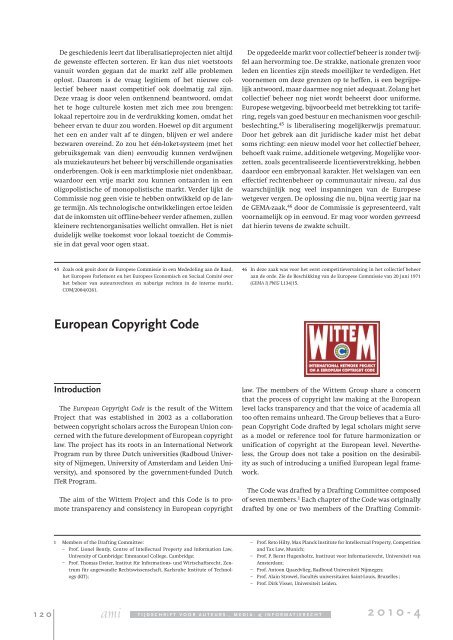
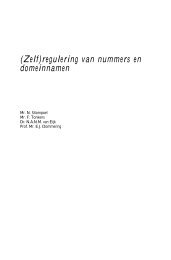
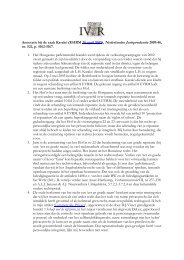

![Legal Opinion of Professor Egbert Dommering [1] concerning ... - IViR](https://img.yumpu.com/23603085/1/184x260/legal-opinion-of-professor-egbert-dommering-1-concerning-ivir.jpg?quality=85)
